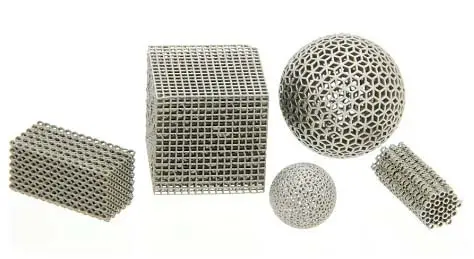Both 3D printing and CNC machining have their advantages and limitations, and CNC machining is an important part of the post-processing step of metal 3D printing and the final application parts to ensure that the parts meet the surface quality requirements and strict tolerances required by customers. By combining these two technologies, complex manufacturing problems can be solved in innovative ways.
Beginning in 2022, Desktop Metal, a leader in binder jetting metal 3D printing, has announced a partnership with SolidCAM to deeply integrate its CNC machining process into the post-processing of binder jetting metal 3D printing. The latter is a global leader in the distribution of innovative CAM software for CNC machining and related digital manufacturing solutions. It supports almost all types of CNC applications, and directly uses CNC programming in the SOLIDWORKS window. The correlation is relatively strong. Once the model changes , the actual tool path will also change accordingly, and the update will be completed automatically.
Desktop Metal has invested heavily in streamlining complex processes to increase the productivity and output of metal parts without undue operator involvement. With complementary expertise, binder jetting metal 3D printing can better realize the end application.
Live Sinter can reduce or avoid part deformation during sintering
The Live Sinter program developed by Desktop Metal integrates extensive knowledge of materials science, uses a multi-physics engine to simulate complex forces and deformations in the sintering process, and can generate “negative offset” geometry in a few minutes, making the sintered Parts conform to their design.
Very complex geometries can be achieved by combining CNC machining and additive manufacturing.
For binder jet metal 3D printing, although the printing process does not require support, in many cases, in order to avoid sintering defects, it is necessary to change the part design, such as setting it as a solid at the position where holes need to be opened. In this case the necessary CNC machining is a must.
In addition to this, with additional processing, very high surface precision can be achieved. At the beginning of part design, combined with the characteristics of the part itself, it is also possible to directly design the fixture required for CNC machining of the part that conforms to the sintering rule of the binder jetting process, which is also meaningful for subsequent processing.
Classification of 3D electronic printing technology
In the field of 3D electronic printing technology, extrusion printing, inkjet printing, spray printing and electrohydrodynamic(EHD) inkjet printing are the most widely used 3D printing technologies in the field of circuit 3D printing research, and these technologies can be used to integrate functional Ink is deposited directly onto the substrate. According to the classification of ISO/ASTM2021:52900, extrusion printing can be classified as material extrusion, while inkjet printing, spray printing and electro-hydraulic jet printing can be classified as material jetting.
1. Extrusion printing
The principle of extrusion-based printing technology is simple and affordable, in which a continuous flow of functional materials is achieved through nozzle extrusion. This technique allows for a wider range of material viscosities and fewer clogging issues than other printing techniques. However, this method is much slower and prints at lower resolution. Depending on the type of extruder used, extrusion-based printing can be further subdivided into filament-based extrusion, pneumatic-based extrusion, plunger-based extrusion, and screw-based extrusion. Pneumatic extrusion, plunger extrusion, and screw extrusion printing technologies are also collectively referred to as direct ink writing (DIW).
2. Inkjet printing
Inkjet printing is a mature technology that has been widely used in many fields over the past few decades. It utilizes inkjet printing technology to build images by depositing ink onto a paper substrate. Using this technology, it is also possible to create 3D printed electronics by depositing electrically functional and conductive materials. Inkjet printing is divided into two categories based on the droplet generation method: continuous inkjet printing (CIJ) and drop-on-demand printing (DoD). In general, inkjet printing technology is digital, non-contact, maskless, and material-saving. However, inkjet printing technology generally faces the problem of nozzle clogging during the printing process. In addition, inkjet printing technology can only deposit low-viscosity fluids within a specific surface tension range. Therefore, this limits the types of inks that can be deposited by inkjet printing. Inkjet printing techniques are also generally not conducive to depositing functional materials onto non-planar surfaces.
3. Spray printing
Spray printing technology is an aerosol-based direct-write printing technology capable of producing directed and collimated aerosol beams for direct deposition of materials onto substrates. This technique is also known as aerodynamic focusing. Typically, spray printers are equipped with pneumatic or ultrasonic atomizers. Pneumatic atomizers can accept inks with viscosities ranging from 1 to 500cps, while ultrasonic atomizers can only accept inks with viscosities ranging from 1 to 15cps. The aerosol jetting process can deposit a range of functional materials for 3D printed electronics applications, including metallic nanoparticle inks, carbon nanotubes (CNTs), graphene, dielectric materials, and conductive polymers. Spray printers have demonstrated the ability to achieve print resolutions of 10 μm. Spray printing technology is also non-contact, reducing buildup contamination and damage.
4. Electro-hydraulic power (EHD) jet printing
In electrohydraulic dynamic (EHD) inkjet printing, an electric field is used to generate an electrofluid in the process of creating fluid flow. This usually requires high pressure to overcome the high capillary pressure in small nozzles, but this may not be technically feasible when the diameter of the nozzle is too small. Therefore, to overcome this problem, EHD inkjet printing technology works by applying an electric field instead of extracting ink from conductive nozzles. EHD jet printing technology can produce very fine lines and tiny droplets in the sub-micron range, and the inner diameter of the nozzle can be as small as 100nm. EHD jetting technology can deposit organic and inorganic materials for 3D printed electronics applications.

